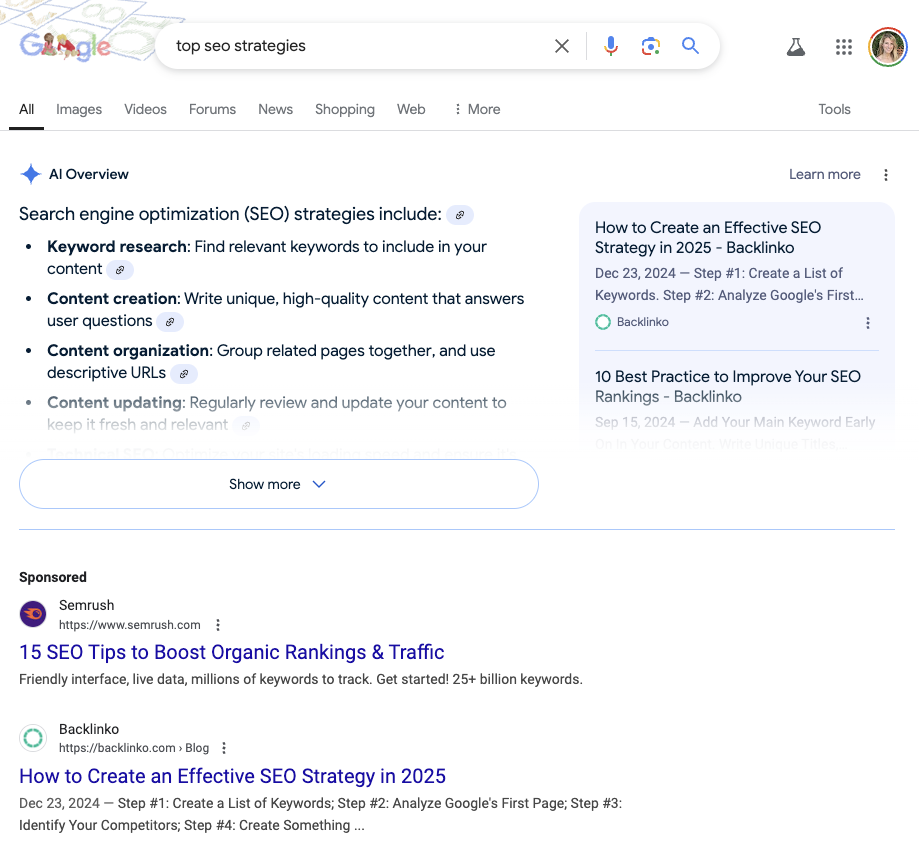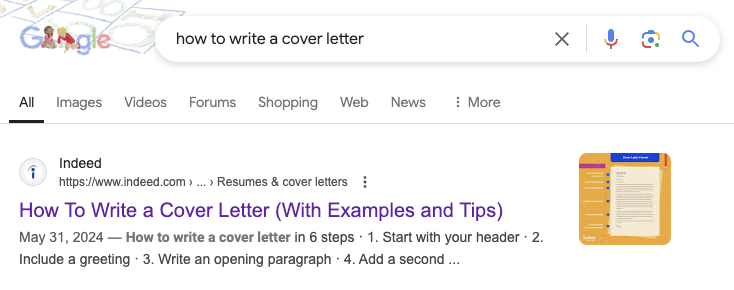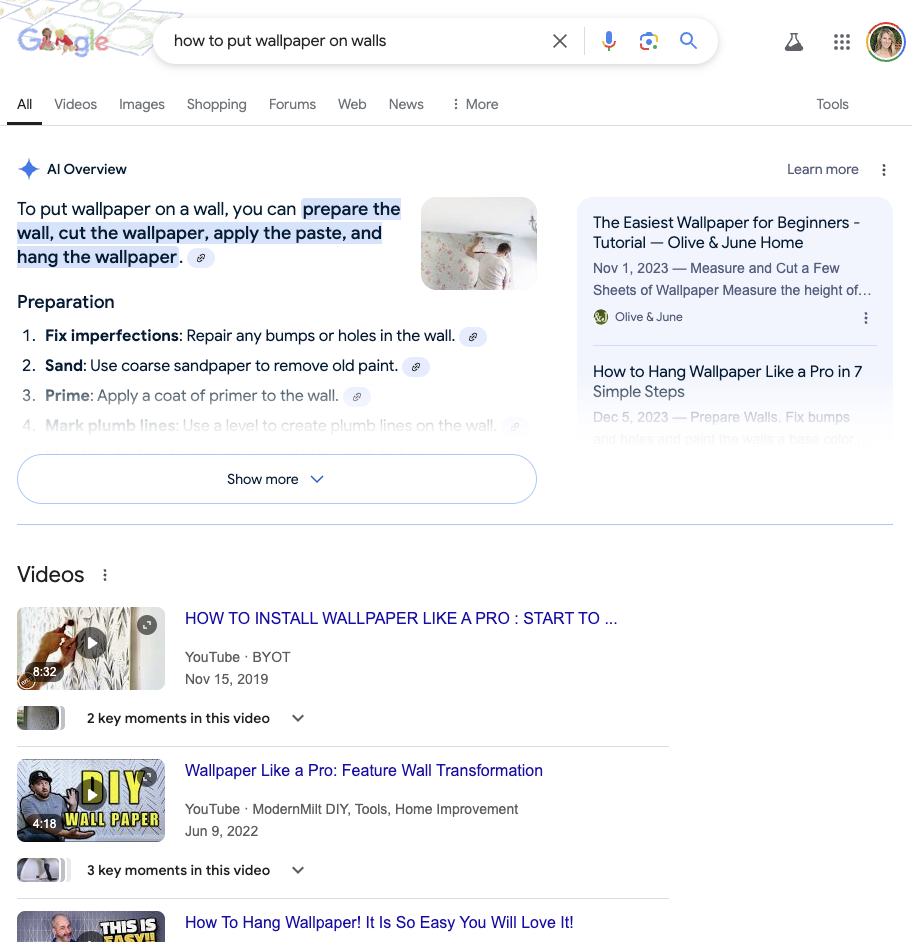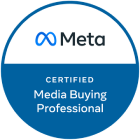It’s a marketer’s holy grail: getting your website to rank #1 on Google.
But achieving and maintaining that position takes more than luck. It takes more than just SEO or PPC.
To get your website to the top of Google, brands must employ multiple marketing strategies—and be ready to evolve those strategies in line with the latest algorithm update.
Follow the strategies below to help your website climb the rankings and stay there.
Sections
1. Optimize for AI overviews
Search engine optimization (SEO) is a cornerstone of ranking at the top of Google. In 2025, getting your website to the top of Google no longer means getting that first blue link, but being featured in the AI overview that sits above it.
Research suggests that nearly half (48%) of the sources mentioned in these overviews are pulled from results on page 2 of Google—or beyond.

To get your website included in an AI overview at the top of Google, focus on these tactics:
- Answer common questions: Use concise, direct language to answer user queries. Google’s AI often pulls content from sites with well-organized FAQs or informative blog posts.
- Use structured data: Schema markup helps Google understand your content and is essential for getting featured in snippets, AI Overviews, and other rich results.
- Write for humans and machines: Combine clear, engaging writing with keyword optimization. Make use of long-tail keywords that mimic conversational search terms, as these often appear in AI summaries.
2. Spot opportunities for barnacle SEO
Barnacle SEO involves “attaching” your brand to high-ranking websites or directories to increase visibility. Instead of relying solely on your site’s ability to rank, you make sure your website (and your content) is featured on platforms that already dominate the SERP (search engine results page) for your desired keywords.
Examples of barnacle SEO include:
- Guest blogging: Write for industry blogs that already rank high in your niche.
- Updating business listings: Create and optimize your profiles on Google Business, Yelp, or other directories relevant to your field.
- Leveraging brand partnerships: Collaborate with complementary businesses that rank well, sharing backlinks or co-marketing campaigns. For example, a running shoes company could partner with a health food company that’s already ranking well.
Here’s what barnacle SEO looks like in action for the health food brand sweetgreen. They rank #1 for their brand name, but they’ve made sure the entire first page of search results points back to them—with listings on Yelp and Google Business, Instagram posts, and mentions in shopping mall directories and newspaper articles:

One added benefit of using barnacle SEO? You gain valuable traffic and backlinks while building brand authority.
3. Invest in Google Ads
While organic SEO is essential, Google Ads can fast-track your visibility in the search results. Paid search campaigns let you target specific keywords and audience segments, ensuring your website appears at the top of relevant searches.
Here’s how to maximize ROI with Google Ads:
- Focus on Quality Score: Google rewards ads that are relevant, have strong click-through rates (CTR), and direct users to optimized landing pages. And, a higher Quality Score lowers your cost per click (CPC)—so you can stretch your budget even further.
- Use AI-driven ads: With various AI-powered ad tech, you can let Google experiment with different combinations of headlines and descriptions to find the highest-performing combinations for your campaigns. Explore Performance Max, Responsive Search and Display, and Smart Bidding strategies to see what works best for your brand.
- Target branded and non-branded keywords: Include keywords specific to your brand alongside broader search terms relevant to your industry.
Pairing Google Ads with SEO ensures maximum visibility across the SERP—including the very top spot on Google if you’re willing to pay for it.
4. Create high-value content
High-value content is the backbone of any successful SEO strategy—all the more so if you want to get your website to the very top of Google. Google’s algorithm rewards websites that consistently provide informative, engaging, and original content.
Here’s a three-pronged strategy for creating content that stands out, and earns your site a spot at the top of the Google search results.
Start with blogs that answer real questions
Blogs are a proven way to drive organic traffic and establish your site as an authority in your niche. To create high-performing blog posts:
- Target common search queries: Review Google’s “People also ask” section to identify the questions your audience is asking. Then create posts that provide detailed answers.
- Format for readability: Break up your content with short paragraphs, bullet points, and headers. This improves user experience and makes it easier for Google to feature your content in snippets and AI Overviews.
- Include visuals: Enhance your blogs with images, charts, videos, and infographics to make them visually appealing and engaging.
A well-optimized blog not only helps your site rank in Google’s search results but can also be a source of material for other content formats like videos and infographics. Speaking of which…
Design infographics that are easy to share
Infographics are a powerful way to present data, statistics, or step-by-step processes in an easy-to-digest format. They’re highly effective at earning backlinks, which improves your rankings, but also featured in the Images tab of Google search.
As you can see in this example, the site at the top of the search results included an infographic in its blog:

Here’s how to make the most of your infographics:
- Choose topics that resonate: Focus on popular or trending subjects within your niche.
- Keep it simple: Use clean design and limit text to key points. Tools like Canva make it easy to create professional-quality graphics without a design background.
- Optimize for SEO: Name the image file with relevant keywords, add alt text, and include a descriptive caption when embedding it on your site.
Infographics also provide opportunities for guest blogging and collaboration. Share your creations with other sites to earn additional exposure and traffic.
Create videos to dominate YouTube and Google’s video search
Videos are one of the fastest-growing content formats online, and they’re highly prioritized in both YouTube and Google’s search algorithms. By creating video content, you can tap into not just the world’s biggest search engine (Google), but also the second biggest (YouTube).
Plus, Google often pulls video results into its SERPs, so videos not only expand your reach on YouTube but also improve your chances of ranking in general search results. As you can see in the example below, the first three results after the AI Overview are YouTube videos:

Here’s how to create first-page worthy videos:
- Optimize for YouTube SEO: Use keywords in your video title, description, and tags. Write detailed descriptions with timestamps and include links back to your website or blog.
- Answer specific questions: Like blogs, your videos should target common search queries. Tutorials, how-tos, and explainer videos perform particularly well.
- Include a call to action: At the end of your video, encourage viewers to visit your website, subscribe, or check out additional resources.
5. Track and adapt to stay on top
Ranking #1 on Google is only part of the equation—you need to maintain your position. Use analytics tools like Google Analytics, Search Console, and third-party SEO tools to monitor your site’s performance. Here’s what to monitor:
- Keyword performance: Which terms are driving traffic, and where can you improve? Keep an eye on Google Trends to prepare for trending keywords, too.
- Competitor analysis: What are your competitors doing differently, and how can you adapt?
- User behavior: Keep an eye on engagement metrics in Google Analytics 4 to ensure your content engages visitors.
Getting your website to the top of Google requires a blend of technical expertise, high-quality content, and strategic advertising. With a multifaceted approach, you can steadily climb the rankings and connect with your audience where they are.
Ready to dominate the SERPs? Contact Your Marketing People today to start implementing these strategies and watch your site rise to the top.







